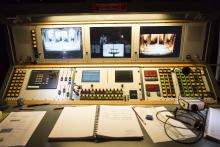The theatre is used by different companies simultaneously. This means that on any one day a production may be built, lit or rehearsed onstage and another production performed in the evening.
Please note that the facilities mentioned below are not always available because they may already be in use for another production.
In addition to the main stage, the theatre has a large stage-right wing, and similarly-sized rear stage and assembly stage. This allows us to host more than one production at a time and to alternate performances between two or more productions. Soundproofing screens separate the main, side and rear stages and can be lowered or raised as necessary.
The main stage is equipped with five stage lifts, each measuring 16.20 m wide x 2.70 m deep. These can be raised, together or independently, to a maximum of 3.05 m, lowered to a maximum of 3.05 m and raked to a maximum of 10%.
A sprung floor is placed on the stage lifts for classical dance productions.
Sets can be moved by scenery wagons that have the same dimensions as the stage lifts. These can be sunk into the floors of the main and assembly stages so that the top of the wagon is level with the surrounding stage area. Horizontal movement of scenery is sometimes done by the use of AGVs (Automated Guided Vehicles). These computer-controlled drives are built into the wagon floors and can, if desired, be built into specific pieces of scenery. Accurate and programmable positioning of this scenery is achieved by the use of lasers and reflectors.
The main stage has a comprehensive fly system comprising 92 electrically powered fly bars, 4 upstage-downstage bars, 3 bars above the forestage, 2 bars above the auditorium, 45 point hoists and 18 winches for a maximum load of 2,000 kilos each. The fly bars are specially constructed ladder trusses with a curtain rail integrated in the bottom pipe.
All stage machinery (except the AGVs) is controlled by a single computer system operated from mobile control desks.
House Curtain
The house curtain is red velvet and can be opened either as a traveller curtain (variable speed) or as a Wagner curtain. The operating console is located next to the curtain, stage left. There is an extra, violet-coloured traveller curtain just in front of the iron (fire) curtain.
Aids
The theatre has standard 'hard' (inflexible), black masking consisting of 8 legs (four pairs). These are aluminium truss frames stretched with black woollen fabric. Also available are 'soft' woollen black legs and borders, and various standard cloths and foils. Other aids include man-lifts, ladders and fork-lift trucks.
Loading & Unloadin
The entrance to the loading bay is next to the stage door at no. 22 Waterlooplein. The covered bay has room for 2 trailers side by side. The maximum trailer height is 4.00 m. The loading platforms are adjustable in height to a maximum of 1.26 m. The bay is not suitable for long-term parking. An electric forklift truck with a maximum capacity of 1,500 kg is available.
Downloads
Measurements and specifications of the stage
A groundplan
A sectional drawing
Should you need a drawing in DWG format, please send an email to the addres below or phone +31 20 551 8094. tom-mt-tekenkamer@operaballet.nl





